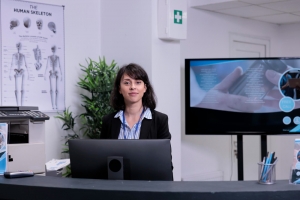please click here:
https://www.reshine-display.com/products.html
Introduction
Projected Capacitive Touch Screens (PCAP) have revolutionized the way we interact with electronic devices, from smartphones and tablets to industrial control panels and medical equipment. Renowned for their high sensitivity, multi-touch capabilities, and durability, PCAP technology is now the dominant touch interface in many sectors. This article provides an in-depth exploration of projected capacitive touch screens, explaining how they work, their construction, advantages, applications, and emerging trends shaping their future.
What Are Projected Capacitive Touch Screens?
Definition and Basic Principle
Projected capacitive touch screens detect touch by sensing changes in an electrostatic field projected through a transparent conductive layer. Unlike resistive touchscreens that rely on physical pressure, PCAP screens use a grid of conductive electrodes beneath the glass surface. When a finger or conductive stylus approaches, it distorts the electrostatic field, causing a measurable change in capacitance that the system uses to pinpoint the exact location of the touch.
How Projected Capacitive Technology Works
-
A matrix of conductive materials such as Indium Tin Oxide (ITO) is arranged in intersecting X and Y layers beneath the glass surface.
-
These layers form capacitors at each intersection, generating an electrostatic field.
-
When a conductive object touches or nears the surface, it draws charge from the electrodes, altering the local capacitance.
-
The touch controller detects these changes and calculates the precise touch coordinates.
-
The system can simultaneously track multiple touch points, enabling complex multi-touch gestures.
This technology allows the touch to be detected even through thin protective layers or gloves, enhancing versatility and usability.
Construction and Components of PCAP Screens
Layered Structure
A typical projected capacitive touch screen consists of several key layers:
-
Cover Glass or Plastic: The outermost layer that users physically touch, often made of durable, scratch-resistant tempered glass.
-
Conductive Electrode Layers: Transparent conductive layers (usually ITO) arranged in a grid pattern on glass or PET substrates.
-
Insulating Layers: These prevent interference and protect the conductive layers.
-
Touch Controller: An integrated circuit that injects electrical signals, monitors capacitance changes, and processes touch data.
Customization Options
Modern PCAP screens can be customized with colored cover glass, corporate logos printed directly on the glass, and various sizes tailored for different applications. Optical bonding techniques are often used to laminate layers without air gaps, improving clarity and durability.
Advantages of Projected Capacitive Touch Screens
High Sensitivity and Multi-Touch Capability
PCAP screens support 10 or more simultaneous touch points with millisecond response times, enabling gestures like pinch-to-zoom, rotate, and multi-finger drawing. This makes them ideal for interactive applications such as gaming, design, and complex user interfaces.
Superior Optical Clarity
With light transmittance exceeding 90%, PCAP screens provide clearer and more vibrant displays compared to resistive touchscreens, which typically transmit around 75% of light. This clarity is crucial for high-resolution OLED and AMOLED displays.
Durability and Reliability
The use of tempered glass and the absence of mechanical moving parts give PCAP screens a theoretical lifespan of over one million touches. They are resistant to scratches, fingerprints, temperature fluctuations, humidity, and electrostatic interference.
Versatility of Input
PCAP technology works with fingers, conductive styluses, and even gloved hands, broadening its usability across different environments and user needs.
Environmental Robustness
PCAP touchscreens maintain performance under various environmental conditions, including exposure to dust, moisture, and temperature extremes, making them suitable for industrial and outdoor use.
Applications of Projected Capacitive Touch Screens
Consumer Electronics
Smartphones, tablets, laptops, and wearable devices widely use PCAP screens to deliver intuitive, responsive touch experiences.
Retail and Hospitality
Interactive kiosks, self-service terminals, and digital signage in stores and restaurants enhance customer engagement and streamline operations.
Industrial Automation
Human-Machine Interface (HMI) panels and control systems rely on PCAP touchscreens for efficient monitoring and control in manufacturing and processing plants.
Medical Devices
Medical-grade PCAP screens enable healthcare professionals to interact with patient records, diagnostic images, and medical applications with precision and hygiene.
Gaming and Entertainment
Gaming consoles, arcade machines, and interactive exhibits benefit from the multi-touch and high responsiveness of PCAP technology to create immersive experiences.
Emerging Trends and Future Developments
Flexible and Curved Displays
Advances in materials allow PCAP screens to be flexible or curved, opening new design possibilities for smartphones, wearables, and automotive displays.
Integration with AI and IoT
Combining PCAP touchscreens with artificial intelligence and Internet of Things technologies enables smarter, connected devices with enhanced functionality.
Enhanced Sensing Capabilities
New sensing technologies, such as force sensing and haptic feedback, improve user experience by adding tactile responses and pressure sensitivity.
Gesture Recognition and Touchless Interaction
Gesture recognition technologies are expanding PCAP use cases by enabling touchless control, important for hygiene-sensitive environments.
Augmented Reality (AR) and Virtual Reality (VR)
Integration with AR and VR technologies is creating immersive interactive experiences for education, gaming, training, and simulation.
Frequently Asked Questions (FAQs)
Q1: How does projected capacitive touch differ from resistive touch technology?
A1: PCAP uses changes in electrostatic fields to detect touch without physical pressure, supporting multi-touch and offering higher sensitivity and clarity, while resistive touch relies on pressure and typically supports only single touch.
Q2: Can PCAP screens work with gloves?
A2: Yes, PCAP screens can detect touch through thin gloves because the electrostatic field extends beyond the surface.
Q3: What materials are used in PCAP touchscreens?
A3: The main materials include tempered glass for the cover, transparent conductive layers like Indium Tin Oxide (ITO), and insulating layers to prevent interference.
Q4: Are PCAP touchscreens durable enough for industrial use?
A4: Yes, they are highly durable, resistant to scratches, temperature, humidity, and electrostatic interference, making them suitable for harsh environments.
Q5: What future innovations are expected in PCAP technology?
A5: Innovations include flexible and curved displays, AI and IoT integration, enhanced sensing like haptics, gesture recognition, and AR/VR compatibility.
Article Summary
Projected Capacitive Touch Screens (PCAP) utilize electrostatic fields and conductive electrode grids to provide highly sensitive, multi-touch, and durable touch interfaces. Widely used in consumer electronics, industrial automation, medical devices, and more, PCAP technology offers superior optical clarity, environmental robustness, and versatile input methods. Emerging trends include flexible displays, AI integration, and gesture recognition, promising exciting future developments in touch technology.






